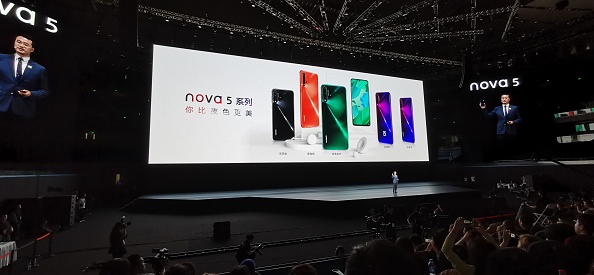The Trump administration seems determined to prove Xi right. Last month, it blacklisted the telecommunications giant Huawei, the third major Chinese company to be added to the Commerce Department’s blandly named Entity List within the last year. Huawei is an indispensable Chinese company, central both to the rollout of China’s 5G mobile network at home and to the country’s efforts to expand its digital influence abroad. The Trump administration is also considering blacklisting several of China’s largest artificial intelligence companies.
The Trump administration is betting that banning Chinese tech companies will bring Beijing to the negotiating table with the aim of negotiating “structural changes” to the Chinese economy. And barring that, it is hoping to deal China a blow in the race to harness next-generation technologies, such as AI and 5G. But within China, the administration’s moves have created a powerful new consensus in support of “self-reliance” and “indigenous innovation,” two mantras of the Chinese Communist Party that the country’s tech industry has reluctantly taken up. Washington has underestimated China’s ability to “tighten its belt,” as Xi put it after the ZTE blacklisting, and to develop replacements for foreign technology. The Trump administration may well be paving the way toward a more technologically independent, and possibly more powerful, China.
THE HISTORY OF SELF RELIANCE
In China, the concept of “self-reliance,” or ziligengsheng, traces its roots back to the civil war, when Mao Zedong’s communist guerrillas found themselves isolated and facing annihilation at the hands of the U.S.-backed nationalist forces. According to Communist Party lore, the communists lived off the land and decentralized the production of economic and military goods as they rebuilt their forces and marshaled their strength. When, in 2014, Xi revived the concept as a call to reduce China’s dependence on foreign technology, the Mao-era slogan seemed an awkward fit for the age of global supply chains.
But China has a long tradition of defying international embargoes. During the Cold War, China succeeded in developing an atomic bomb even after the Soviet Union had cut off its technical support. Throughout the 1990s, China developed sophisticated satellites and rockets despite comprehensive U.S. sanctions on space-related technologies. In 2015, when the Obama administration prevented Intel from selling processors to China for its latest supercomputer, Chinese researchers quickly developed a local replacement. Less than a year and a half later, China unveiled TaihuLight, then the world’s fastest supercomputer, which ran entirely on Chinese-made processors.
These successes are partly the result of official policy. For decades, the Chinese government has urged scientists and researchers to go about their work with “the spirit of two bombs, one satellite”—a reference to China’s nuclear and missile programs during the height of the country’s isolation in the 1960s. To make the spirit a reality, China has developed a sprawling network of state and military research labs, including the Chinese Academy of Science, arguably the world’s largest research organization, with 115 research centers and 60,000 scientists.
This investment has translated into a formidable capacity for indigenous development, either through copying, and then building on, foreign technologies or through developing homegrown alternatives. China’s space sector, which has been almost entirely cut off from the United States for the past two decades, has built most of its satellites and rocket components from scratch. U.S. export controls on space-grade microchips have “actually benefitted China in unexpected ways over the years, because we’ve had to develop our own,” Zhao Yuanfu, a top state scientist, told the online magazine Sixth Tone in February. After nearly a decade of work, China produces all the microchips it needs for advanced satellites, including the BeiDou Navigation Satellite constellation, China’s answer to the U.S. military-run Global Positioning System.
But indigenous development takes hold only when foreign options run out, and few tech sectors in China are as cut off from the outside world as the space industry. For decades, Chinese researchers, at the behest of Chinese leaders seeking “secure and controllable” IT systems, have worked on a domestic alternative to Microsoft Windows. But the weak demand for a home-grown operating system due to the wide availability of foreign alternatives, not to mention the sheer complexity of building one from scratch, has stymied their efforts. China has also invested heavily in disrupting Intel and AMD’s near duopoly on cutting-edge central processing units. Yet Chinese developers continue to rely on more advanced foreign CPUs, which are more powerful and versatile than home-grown Chinese CPUs. As a result, even as China’s economic and political power has expanded, its economy has grown more, not less, dependent on foreign technology and components.
“The biggest challenge for indigenous innovation is not technology, talent, or capital, but the market,” Gao Xudong, a researcher at Tsinghua University, said in a 2017 interview. “Even if we produce a good product through indigenous innovation, it will not succeed if there is no market.” China’s technology industry illustrates the problems markets pose to Beijing’s self-reliance push. The wide availability of superior foreign software and hardware has hampered progress. Moreover, China’s tech giants have long been noncommittal toward Beijing’s self-reliance drive, choosing to invest in lucrative consumer-facing applications rather than the “core technologies” that the state values. The country’s three largest tech companies, Baidu, Alibaba, and Tencent, all owe their large valuations to consumer products built on Western technologies. None other than Huawei founder Ren Zhengfei has repeatedly bashed the idea of indigenous innovation and extolled the advantages of global supply chains. “The idea that one needs to do everything themselves is a mentality only for peasants,” Ren said in an interview last year.

HUAWEI OR THE HIGHWAY
Blacklisting Huawei, however, has turbocharged the indigenous innovation effort. As a result of the blacklisting, the company plans to launch a replacement for Google’s Android operating system later this year. It is also working to replace a myriad of U.S. components and software to which it will soon lose access. Last week, Bloomberg reported that Huawei has up to 10,000 developers working around the clock in three cities to “eliminate the need for American software and circuitry.”
Beneath this burst of outward activity, a quieter and more consequential shift is taking place. U.S. action against Chinese companies has begun to change their calculus toward indigenous development. Reeling from U.S. sanctions, Huawei executives traveled to Peking University last week to launch an R & D partnership with the university to bolster Huawei’s capacity for “indigenous innovation.” By using the official slogan, Huawei’s bosses seemed to be offering a mea culpa for their past resistance to self-reliance. Other executives have also changed their tune. Reflecting on the ZTE incident, Jack Ma, the founder of Alibaba, told a recent tech forum, “If we do not master the core technologies, we will be building roofs on other people’s walls and planting vegetables in other people's yards.” After the ZTE incident last year, Alibaba launched a chip business that will aim to reduce China’s dependence on foreign chips.
Even before the Trump administration began blacklisting Chinese tech companies, Beijing had advanced toward self-reliance. In 2014, the government launched a massive initiative to reduce China’s dependence on foreign chips. As part of that push, it will invest more than $100 billion in semiconductor design and manufacturing. Made in China 2025, the 2015 master plan to upgrade China’s industrial capacity, specifically targets foreign inputs in high-tech sectors and aims for “self-sufficiency” in crucial components. China has also begun mobilizing its financial markets, establishing a new “tech board” on the Shanghai Stock Exchange to invest in companies working on technology the state deems strategically important.
Yet the United States may find that it has done more for self-reliance by banning ZTE and Huawei than the Chinese government has managed in a decade of official policy. Now that they are walking in lockstep, government and industry can move much faster. An international juggernaut with annual revenue comparable to that of Microsoft, Huawei can pour a lot of money into replacing core U.S. technology in its products. What is more important, by intentionally sourcing from Chinese suppliers, large companies such as Huawei can provide Chinese component makers with crucial opportunities to gain experience and develop new technical competencies. On average, Chinese chip and optical component suppliers are inferior to international leaders, since they lack scale and the ability to iterate their products with large customers. Orders from a company of Huawei’s size could change that.
Replacing the many U.S. suppliers on which Chinese companies rely will be a tall order, and at least in the short term, Chinese suppliers will be unable to fully meet the needs of companies such as Huawei. Advanced processors and chipsets that power the cutting-edge computation involved in machine learning, cloud computing, and 5G networks are almost exclusively developed by a handful of Western companies. Although some Chinese companies, such as Huawei’s chip unit HiSilicon, can build their own chips for some applications, they still rely on U.S. software and intellectual property to design the chips and international foundries, such as Taiwan’s TSMC, to manufacture them.
Nevertheless, China does have several factors working in its favor. For starters, it doesn’t need to develop everything itself. Chinese companies have long been comfortable acquiring technology abroad through partnerships, mergers and acquisitions, or outright intellectual property theft. U.S.export controls wouldn’t stop most of these, as they restrict only the export of U.S. technology or foreign products that contain significant U.S.-origin software or components. Technological partnerships and academic exchanges between China and the European Union played a critical role in China’s development of the BeiDou constellation. And Chinese state-backed funds, often using offshore shell companies, have proved adept at evading scrutiny from U.S. sanction enforcers. As the U.S. technological embargo expands, so will the opportunities to poke holes in it.
Another advantage is China’s enormous domestic market. Few companies outside the United States are able to turn down opportunities to sell in China, and even fewer governments are willing to stomach the economic pain of turning away Chinese demand at Washington’s say-so.
Although in the short term the pain imposed on China’s tech industry by the blacklisting might appear to vindicate the administration’s move, over the long term its actions will pave the way to a more technologically formidable China.
This article was originally published on ForeignAffairs.com.








